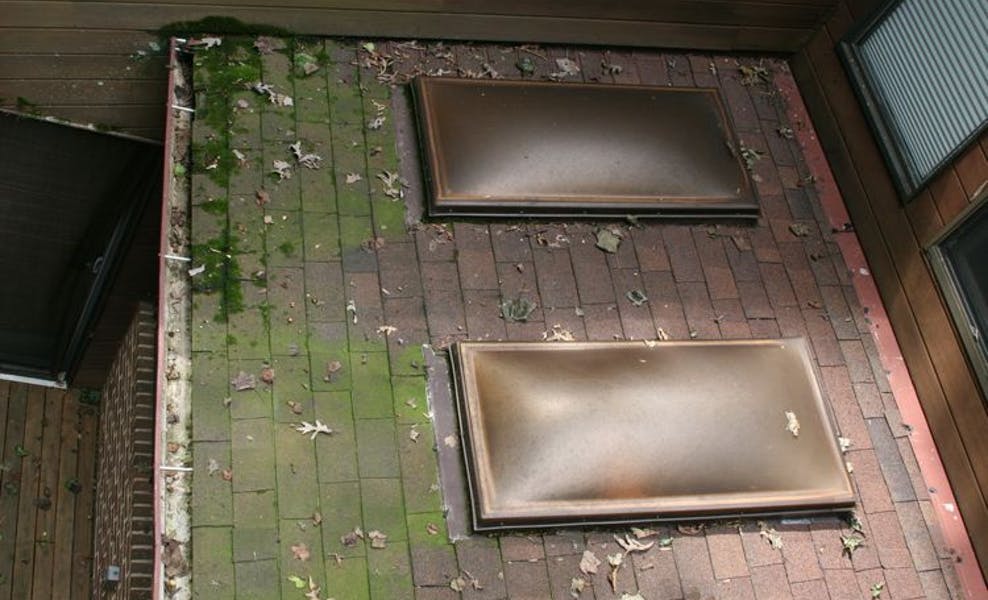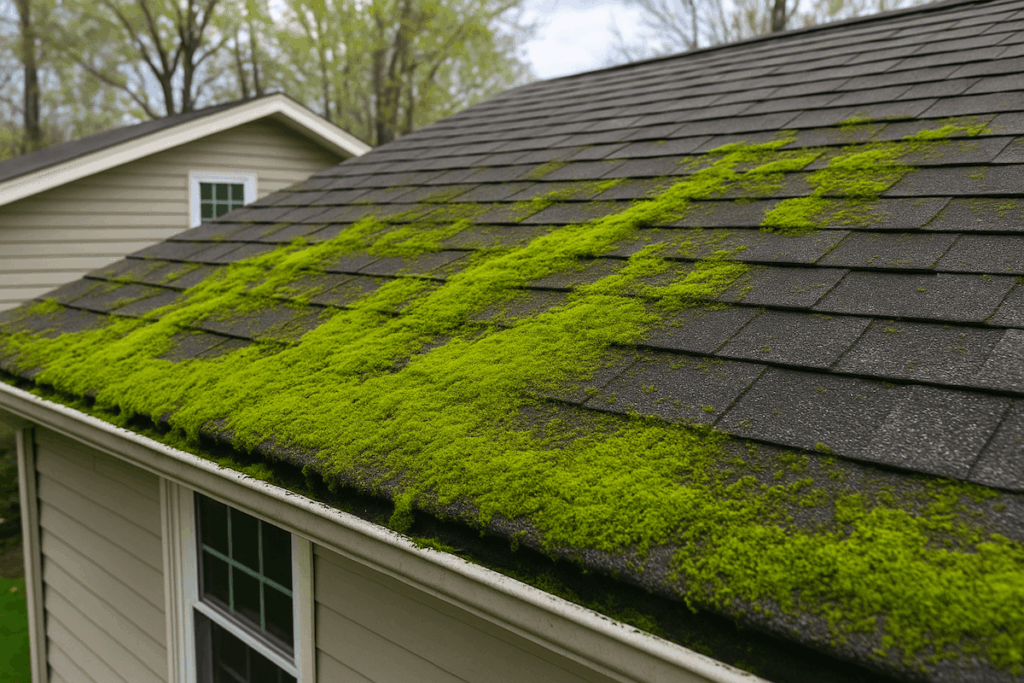If you start to see green patches spreading across your shingles, it may seem like a minor cosmetic issue. For many Maryland homes, that growth can become a significant roofing issue, affecting leaks, energy efficiency, and even the structural integrity of your roof.
Moss grows rapidly on many Maryland roofs because our homes experience long periods of shade, consistent humidity, and weather patterns that keep shingles damp for hours. We pay close attention to this issue because moss can shorten a roof’s lifespan when it spreads across valleys, edges, and older shingle surfaces. Homeowners often call us after noticing green patches appear along the darker portions of their roof, and we guide them through a process that restores the surface while protecting the underlying structure.

What Causes Moss To Grow On Maryland Roofs
Moss thrives in moisture. Maryland’s climate produces rain across every season, along with humidity that keeps roofs damp through the night and early morning. When shingles stay wet for long periods, spores settle in, and patches form along the least sunny parts of a roof.
Trees offer shade and comfort, but the reduced sunlight keeps parts of a roof from drying. Moss spreads quickly in these zones, especially on north-facing slopes that receive the least direct sunlight.
When inspecting an older roof, we often see early moss growth directly on areas where the granules on asphalt shingles have thinned. Older shingles also tend to hold moisture longer than newer products. Weathering leads to granule loss, and once bare spots develop, the surface becomes more absorbent. This environment gives moss an easy surface to cling to.
Why Moss Is A Serious Problem For Roof Shingles
Many Maryland homeowners schedule service after noticing new leaks during storms. Moss does not create leaks on its own. The problem develops through the trapped moisture and the weakening of the surface. Removing the moss and repairing the underlying issues solves the problem, but fast action produces better results.
The added weight of moss is minimal, yet the impact on the shingles can be significant. Moss pushes against the edges of shingles as it grows. This pressure lifts the material, exposing the layers below.
The surface begins to lose granules faster than normal when moss spreads. Granules give shingles their strength. Once they erode, the asphalt underneath ages quickly because there is no protective layer in place.
Moisture that rests beneath patches of moss often seeps downward. Roof decks absorb this moisture when the problem continues for weeks or months. Soft spots form, and in some cases, we locate sections where the plywood has weakened. When moss reaches this stage, roof repairs become more involved and the total cost increases.

Early Signs Of Moss Growth Homeowners Should Watch For
Dark green or vivid green patches along the shaded side of a roof usually signal moss. These patches appear in clusters or lines, especially along valleys. Valleys stay wet longer because rainwater collects in those areas before draining.
Moss also forms along the bottom edges of shingles and spreads upward. When a homeowner sees thick mats at the lower portion of the roof, the problem has already been active for a while.
Shingles that appear lifted or curled may have moss underneath. Sometimes this is visible from the ground. In other cases, we determine the extent of moss growth through a thorough roof inspection.
Granule loss in gutters can also be a sign. While granule loss occurs naturally over time, a sudden increase during cleaning often correlates with moss growth. Moss loosens granules as it expands across the surface.
Black streaking indicates a different issue. Streaks come from algae, not moss, but many homeowners confuse the two. During an inspection, we check for both so the proper cleaning method is used.
Safe Ways To Remove Moss From A Roof
We begin every moss removal service with a full inspection. This step allows us to note soft spots, shingle movement, flashing condition, gutter flow, and the amount of moss present. Every roof responds differently based on age, slope, and the amount of previous wear.
Soft-washing is the safest cleaning method for shingles. High pressure removes granules, cuts into the surface, and voids warranties. Soft-washing uses gentle water flow and cleaning agents approved by shingle manufacturers. This combination removes moss while keeping the roof intact.
Manual removal works well for thick patches. We use soft brushes and hand tools that clear the moss without tearing the shingles. The process takes time, and we apply it carefully to avoid surface damage.
Eco-friendly treatments provide long-term benefits. These cleaning solutions break down the remaining spores and help slow new growth. We select treatments that comply with manufacturer guidelines and keep the roof system protected.
Moss Removal Methods To Avoid
- Pressure washers cause unnecessary damage. Even household units with low settings force water into the surface and dislodge granules rapidly.
- Bleach mixes found online can damage shingles and siding. These solutions dry out materials, corrode components, and cause stains on nearby landscaping.
- Abrasive brushing removes granules and scratches the shingle coating. Many homeowners attempt this first, but it often leads to costly repairs.
- Walking directly across older shingles can break the surface when the decking underneath is compromised. A professional approach keeps weight off fragile areas.

When Moss Signals That a Roof Needs Replacement
Some roofs reach a stage where cleaning will not restore the shingle performance. When moss embeds itself deeply and the granules have worn thin, the shingles lose their ability to protect the home. Older roofs experience this first because their surfaces already show signs of stress.
If we find soft decking or structural issues during our inspection, a complete roof replacement often provides better long-term value. We review these findings with the homeowner and explain the condition of each section.
Roof Types in Maryland That Attract Moss
Asphalt shingles are the most common roofing material for Maryland homes. Moss attaches easily to the surface granules of asphalt shingles. Older shingle roofs with worn texture accumulate more moisture, which accelerates moss growth. Wood shake roofs experience the same problem because they absorb water.
Homeowners with shaded roof areas, especially sections facing north, see faster growth. These surfaces dry slower because sunlight cannot reach them. Over time, moss works into small gaps beneath shingles and holds moisture in place.
Common Areas Where Moss Takes Hold
Moss usually forms in clusters. It prefers valleys, the backsides of skylights, and zones beneath large tree limbs. These pockets trap moisture and hold debris that stays wet after storms. If you live near wooded areas or streets lined with tall trees, you will see these zones develop sooner than more open areas of the roof.
Moss, Algae, And Lichen: How They Differ
The growth of moss, algae, and lichen can all have negative impacts on your roof, but how they are addressed can vary slightly. Moss grows in raised patches and spreads through moisture. Algae appears as streaking and stays flat against the surface. Lichen attaches firmly and creates hardened spots that require careful removal.
Each growth responds to different cleaning techniques. When we inspect a roof, we identify every type present so the right treatment plan is used. This ensures safe removal without damaging the roof.
Why Homeowners Choose RoofPRO For Moss Removal
We serve Maryland communities and understand how local weather affects shingle performance. Our teams follow manufacturer guidelines during cleaning and repair. Each project receives a full inspection, careful moss removal, and long-term prevention options.
Homeowners rely on us because we communicate clearly, work safely, and explain every part of the process. We provide honest evaluations that help homeowners understand when cleaning is enough and when replacement produces better value. Our goal is to protect the home while extending the life of the roofing system.
Schedule Moss Removal With RoofPRO
Moss removal restores the condition of your roof and prevents long-term moisture damage. Maryland homeowners rely on RoofPRO because the company understands local climate conditions and roofing materials. If you have growth on your roof or need an inspection, contact us today to schedule a visit and protect your home before the next storm arrives.

Author Bio
Tim Taylor – Owner & Founder of RoofPRO
Tim Taylor began his roofing career in 2003 and founded RoofPRO in 2004 with a mission to fix the poor workmanship that often causes roof leaks. With over 20 years of hands-on experience, he’s earned elite credentials like CertainTeed’s ShingleMaster Wizard certification, HAAG inspection certifications, and OSHA safety training. His expertise in leak repair, flashing repair, and post-storm restoration has made RoofPRO one of Maryland’s most trusted roofing companies. Tim continues to lead with the same principle that built his reputation—roof it right the first time.

